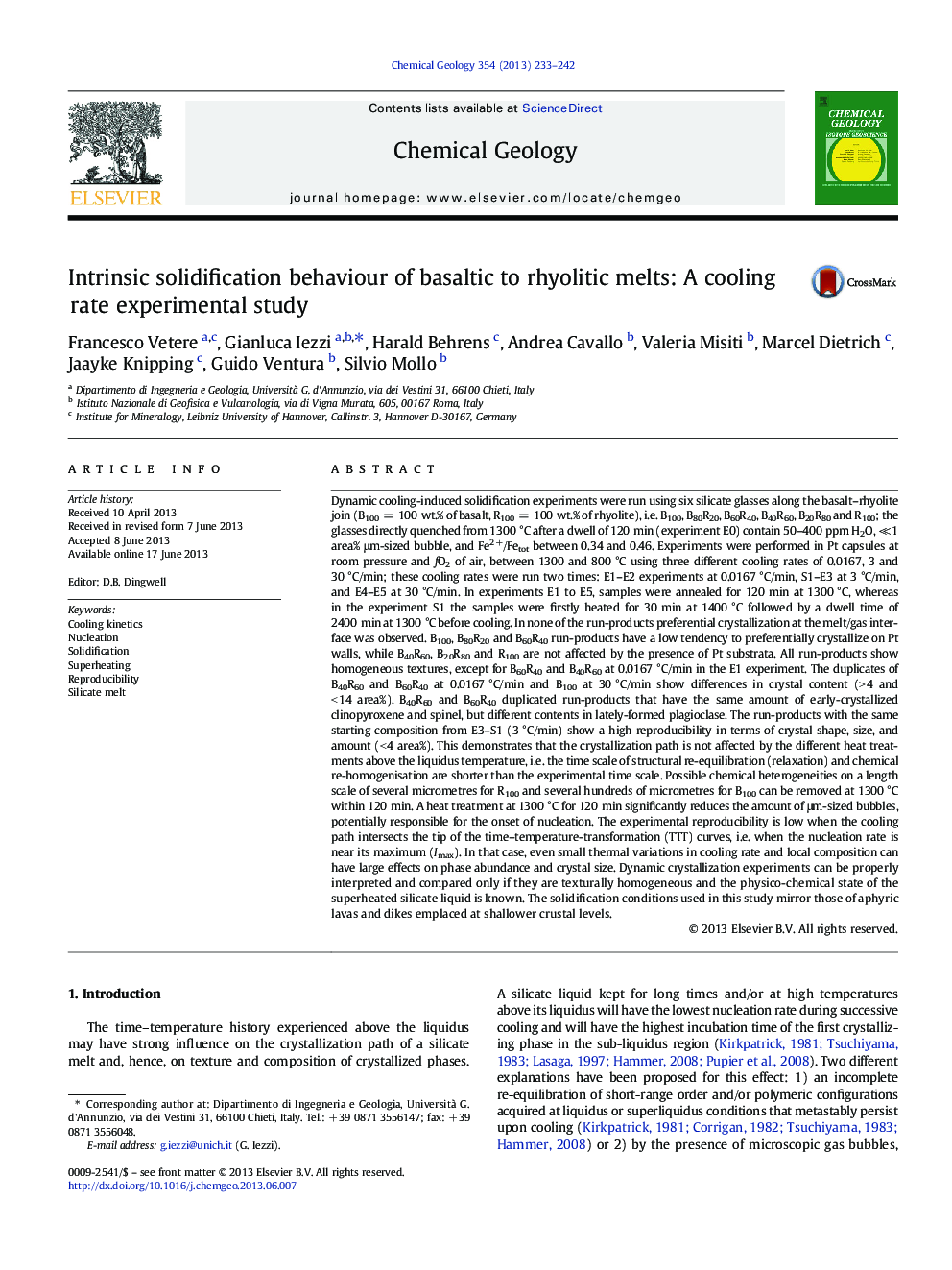| کد مقاله | کد نشریه | سال انتشار | مقاله انگلیسی | نسخه تمام متن |
|---|---|---|---|---|
| 6436853 | 1637615 | 2013 | 10 صفحه PDF | دانلود رایگان |
- Constraints for the interpretation of dynamic solidification experiments
- Interpretation of the superheating effect on successive nucleation features
- Reproducibility of textures in dynamic cooling experiments
- Intrinsic nucleation and solidification properties of natural silicate melts
Dynamic cooling-induced solidification experiments were run using six silicate glasses along the basalt-rhyolite join (B100 = 100 wt.% of basalt, R100 = 100 wt.% of rhyolite), i.e. B100, B80R20, B60R40, B40R60, B20R80 and R100; the glasses directly quenched from 1300 °C after a dwell of 120 min (experiment E0) contain 50-400 ppm H2O, âªÂ 1 area% μm-sized bubble, and Fe2 +/Fetot between 0.34 and 0.46. Experiments were performed in Pt capsules at room pressure and fO2 of air, between 1300 and 800 °C using three different cooling rates of 0.0167, 3 and 30 °C/min; these cooling rates were run two times: E1-E2 experiments at 0.0167 °C/min, S1-E3 at 3 °C/min, and E4-E5 at 30 °C/min. In experiments E1 to E5, samples were annealed for 120 min at 1300 °C, whereas in the experiment S1 the samples were firstly heated for 30 min at 1400 °C followed by a dwell time of 2400 min at 1300 °C before cooling. In none of the run-products preferential crystallization at the melt/gas interface was observed. B100, B80R20 and B60R40 run-products have a low tendency to preferentially crystallize on Pt walls, while B40R60, B20R80 and R100 are not affected by the presence of Pt substrata. All run-products show homogeneous textures, except for B60R40 and B40R60 at 0.0167 °C/min in the E1 experiment. The duplicates of B40R60 and B60R40 at 0.0167 °C/min and B100 at 30 °C/min show differences in crystal content (> 4 and < 14 area%). B40R60 and B60R40 duplicated run-products that have the same amount of early-crystallized clinopyroxene and spinel, but different contents in lately-formed plagioclase. The run-products with the same starting composition from E3-S1 (3 °C/min) show a high reproducibility in terms of crystal shape, size, and amount (< 4 area%). This demonstrates that the crystallization path is not affected by the different heat treatments above the liquidus temperature, i.e. the time scale of structural re-equilibration (relaxation) and chemical re-homogenisation are shorter than the experimental time scale. Possible chemical heterogeneities on a length scale of several micrometres for R100 and several hundreds of micrometres for B100 can be removed at 1300 °C within 120 min. A heat treatment at 1300 °C for 120 min significantly reduces the amount of μm-sized bubbles, potentially responsible for the onset of nucleation. The experimental reproducibility is low when the cooling path intersects the tip of the time-temperature-transformation (TTT) curves, i.e. when the nucleation rate is near its maximum (Imax). In that case, even small thermal variations in cooling rate and local composition can have large effects on phase abundance and crystal size. Dynamic crystallization experiments can be properly interpreted and compared only if they are texturally homogeneous and the physico-chemical state of the superheated silicate liquid is known. The solidification conditions used in this study mirror those of aphyric lavas and dikes emplaced at shallower crustal levels.
Journal: Chemical Geology - Volume 354, 16 September 2013, Pages 233-242
